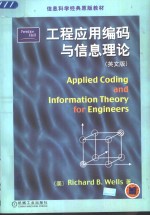

工程应用编码与信息理论 英文版PDF电子书下载
- 电子书积分:12 积分如何计算积分?
- 作 者:(美)Richard B. Wells著
- 出 版 社:北京:机械工业出版社
- 出版年份:2002
- ISBN:711110983X
- 页数:305 页
1.DISCRETESOURCESANDENTROPY 1
1.1OverviewofDigitalCommunicationandStorageSystems 1
1.2DiscreteInformationSourcesandEntropy 2
1.2.1Sourcealphabetsandentropy, 2
1.2.2Jointandconditionalentropy, 6
1.2.3Entropyofsymbolblocksandthechainrule, 8
1.3SourceCoding 10
1.3.1Mappingfunctionsandefficiency, 10
1.3.2Mutualinformation, 12
1.3.3Abriefdigressiononencryption, 14
1.3.4Summaryofsection1.3, 15
1.4.1Prefixcodesandinstantaneousdecoding, 16
1.4HuffmanCoding 16
1.4.2ConstructionofHuffmancodes, 17
1.4.3Hardwareimplementationapproaches, 19
1.4.4RobustnessofHuffmancodingefficiency, 20
1.5DictionaryCodesandLempel-ZivCoding 21
1.5.1Therationalebehinddynamicdictionarycoding, 21
1.5.2Alinked-listLZalgorithm, 22
1.5.3Thedecodingprocess, 25
1.5.4Large-blockrequirementofLZcompression, 26
1.6ArithmeticCoding 28
1.6.1Code-wordlengthandtheasymptoticequipartitionproperty, 28
1.6.2Thearithmeticcodingmethod, 30
1.6.3Decodingarithmeticcodes, 32
1.6.4Otherissuesinarithmeticcoding, 33
1.7SourceModelsandAdaptiveSourceCoding 34
1.8ChapterSummary 35
References 36
Exercises 37
2.CHANNELSANDCHANNELCAPACITY 39
2.1TheDiscreteMemorylessChannelModel 39
2.1.1Thetransitionprobabilitymatrix, 39
2.1.2Outputentropyandmutualinformation, 41
2.2ChannelCapacityandtheBinarySymmetricChannel 43
2.2.1Maximizationofmutualinformationandchannelcapacity, 43
2.2.2Symmetricchannels, 45
2.3.1Equivocation, 48
2.3BlockCodingandShannon sSecondTheorem 48
2.3.2Entropyrateandthechannel-codingtheorem, 49
2.4MarkovProcessesandSourceswithMemory 51
2.4.1Markovprocesses, 51
2.4.2Steady-stateprobabilityandtheentropyrate, 54
2.5MarkovChainsandDataProcessing 56
2.6ConstrainedChannels 58
2.6.1Modulationtheoryandchannelconstraints, 58
2.6.2Linearandtime-invariantchannels, 60
2.7AutocorrelationandPowerSpectrumofSequences 62
2.7.1Statisticsoftimesequences, 62
2.7.2Thepowerspectrum, 64
2.8.1Constraintsondatasequences, 68
2.8DataTranslationCodes 68
2.8.2Statespaceandtrellisdescriptionsofcodes, 70
2.8.3Capacityofadatatranslationcode, 73
2.9(d,k)Sequences 75
2.9.1Run-length-limitedcodesandmaxentropicsequences, 75
2.9.2Powerspectrumofmaxentropicsequences, 77
2.10ChapterSummary 82
References 83
Exercises 83
3.RUN-LENGTH-LIMITEDCODES 89
3.1GeneralConsiderationsforDataTranslationCoding 89
3.2PrefixCodesandBlockCodes 91
3.2.1Fixed-lengtnblockcodes, 91
3.2.2Variable-lengthblockcodes, 92
3.2.3PrefixcodesandtheKraftinequality, 94
3.3State-DependentFixed-LengthBlockCodes 96
3.4Variable-LengthFixed-RateCodes 98
3.5Look-AheadCodes 102
3.5.1Code-wordconcatenation, 102
3.5.2Thekconstraint, 104
3.5.3Informalandformaldesignmethods, 105
3.6DC-FreeCodes 107
3.6.1Therunningdigitalsumandthedigitalsumvariation, 107
3.6.2State-splittingandmatchedspectralnullcodes, 109
3.7ChapterSummary 114
Exercises 115
References 115
4.LINEARBLOCKERROR-CORRECTINGCODES 117
4.1GeneralConsiderations 117
4.1.1Channelcodingforerrorcorrection, 117
4.1.2Errorratesanderrordistributionforthebinarysymmetricchannel, 118
4.1.3Errordetectionandcorrection, 121
4.1.4Themaximumlikelihooddecodingprinciple, 123
4.1.5Hammingdistancecodecapability, 124
4.2BinaryFieldsandBinaryVectorSpaces 126
4.2.1Thebinaryfield, 126
4.2.2Representinglinearcodesinavectorspace, 130
4.3.1Elementarypropertiesofvectorspaces, 131
4.3LinearBlockCodes 131
4.3.2Hammingweight,Hammingdistance,andtheHammingcube, 133
4.3.3TheHammingsphereandboundsonredundancyrequirements, 135
4.4DecodingLinearBlockCodes 136
4.4.1Completedecodersandbounded-distancedecoders, 136
4.4.2Syndromedecodersandtheparity-checktheorem, 138
4.5HammingCodes 140
4.5.1ThedesignofHammingcodes, 140
4.5.2ThedualcodeofaHammingcode, 143
4.5.3TheexpandedHammingcode, 144
4.6ErrorRatePerformanceBoundsforLinearBlockError-CorrectingCodes 147
4.6.1Blockerrorrates, 147
4.6.2Biterrorrate, 148
4.7PerformanceofBounded-DistanceDecoderswithRepeatRequests 149
4.7.1Approximateerrorperformance, 152
4.7.2EffectivecoderateofARQsystems, 154
4.7.3ARQprotocols, 156
4.8ChapterSummary 157
References 158
Exercises 158
5.CYCLICCODES 160
5.1DefinitionandPropertiesofCyclicCodes 160
5.2PolynomialRepresentationofCyclicCodes 162
5.3.1Polynomialrings, 164
5.3PolynomialModuloArithmetic 164
5.3.2Someimportantalgebraicidentities, 166
5.4GenerationandDecodingofCyclicCodes 169
5.4.1Generator,parity-check,andsyndromepolynomials, 169
5.4.2Systematiccycliccodes, 169
5.4.3Hardwareimplementationofencodersforsystematiccycliccodes, 171
5.4.4Hardwareimplementationofdecodersforcycliccodes, 174
5.4.5TheMeggittdecoder, 175
5.5Error-TrappingDecoders 178
5.5.1Updatingthesyndromeduringcorrection, 178
5.5.2Bursterrorpatternsanderrortrapping, 180
5.6SomeStandardCyclicBlockCodes 184
5.6.1TheHammingcodes, 184
5.6.2BCHcodes, 185
5.6.3Burst-correctingcodes, 186
5.6.4Cyclicredundancycheckcodes, 187
5.7SimpleModificationstoCyclicCodes 189
5.7.1Expandingacode, 189
5.7.2Shorteningacode, 190
5.7.3Noncyclicityofshortenedcodes, 193
5.7.4Interleaving, 194
5.8ChapterSummary 197
References 197
Exercises 198
6.1DefinitionofConvolutionalCodes 201
6.2.1Thestatediagramandtrellisrepresentations, 205
6.2StructuralPropertiesofConvolutionalCodes 205
6.CONVOLUTIONALCODES 207
6.2.2Transferfunctionsofconvolutionalcodes, 207
6.3TheViterbiAlgorithm 210
6.4WhytheViterbiAlgorithmWorksⅠ:Hard-DecisionDecoding 215
6.4.1Maximumlikelihoodunderhard-decisiondecoding, 215
6.4.2Erroreventprobability, 217
6.4.3Boundsonbiterrorrate, 219
6.5SomeKnownGoodConvolutionalCodes 221
6.6WhytheViterbiAlgorithmWorksⅡ:Soft-DecisionDecoding 223
6.6.1Euclideandistanceandmaximumlikelihood, 223
6.6.2Eliminationoftiesandinformationloss, 226
6.6.3Calculationofthelikelihoodmetric, 228
6.7TheTracebackMethodofViterbiDecoding 229
6.8PuncturedConvolutionalCodes 234
6.8.1Puncturing, 234
6.8.2Goodpuncturedconvolutionalcodes, 236
6.9ChapterSummary 238
References 239
Exercises 239
7.TRELLIS-CODEDMODULATION 242
7.1Multiamplitude/MultiphaseDiscreteMemoryless 242
Channels 242
7.1.1I—Qmodulation, 242
7.1.2Then-aryPSKsignalconstellation, 243
7.1.3PSKerrorrate, 245
7.1.4Quadratureamplitudemodulation, 247
7.2SystematicRecursiveConvolutionalEncoders 248
7.3SignalMappingandSetPartitioning 251
7.4KnownGoodTrellisCodesforPSKandQAM 254
7.5ChapterSummary 257
References 257
Exercises 258
8.INFORMATIONTHEORYANDCRYPTOGRAPHY 259
8.1Cryptosystems 259
8.1.1Basicelementsofciphersystems, 259
8.1.2Somesimpleciphersystems, 261
8.2AttacksonCryptosystems 265
8.3PerfectSecrecy 266
8.4LanguageEntropyandSuccessfulCiphertextAttacks 269
8.4.1Thekey-equivocationtheorem, 269
8.4.2Spuriouskeysandkeyequivocation, 270
8.4.3Languageredundancyandunicitydistance, 271
8.5ComputationalSecurity 272
8.6DiffusionandConfusion 274
8.7ProductCipherSystems 275
8.7.1Commuting,noncommuting,andidempotentproductciphers, 276
8.7.2Mixingtransformationsandgoodproductciphers, 278
8.8Codes 279
8.9Public-KeyCryptosystems 280
8.11ChapterSummary 281
8.10OtherIssues 281
References 282
Exercises 283
9.SHANNON SCODINGTHEOREMS 285
9.1RandomCoding 285
9.2TheAverageRandomCode 287
9.3ADiscussionofShannon sSecondTheorem 289
9.4Shannon-FanoCoding 290
9.5Shannon sNoiseless-CodingTheorem 292
9.6AFewFinalWords 293
References 294
ANSWERSTOSELECTEDEXERCISES 295
INDEX 299
- 《市政工程基础》杨岚编著 2009
- 《SQL与关系数据库理论》(美)戴特(C.J.Date) 2019
- 《钒产业技术及应用》高峰,彭清静,华骏主编 2019
- 《现代水泥技术发展与应用论文集》天津水泥工业设计研究院有限公司编 2019
- 《联吡啶基钌光敏染料的结构与性能的理论研究》李明霞 2019
- 《工程静力学》王科盛主编 2019
- 《情报学 服务国家安全与发展的现代情报理论》赵冰峰著 2018
- 《英汉翻译理论的多维阐释及应用剖析》常瑞娟著 2019
- 《中央财政支持提升专业服务产业发展能力项目水利工程专业课程建设成果 设施农业工程技术》赵英编 2018
- 《新课标背景下英语教学理论与教学活动研究》应丽君 2018
- 《指向核心素养 北京十一学校名师教学设计 英语 七年级 上 配人教版》周志英总主编 2019
- 《北京生态环境保护》《北京环境保护丛书》编委会编著 2018
- 《高等教育双机械基础课程系列教材 高等学校教材 机械设计课程设计手册 第5版》吴宗泽,罗圣国,高志,李威 2018
- 《指向核心素养 北京十一学校名师教学设计 英语 九年级 上 配人教版》周志英总主编 2019
- 《高等院校旅游专业系列教材 旅游企业岗位培训系列教材 新编北京导游英语》杨昆,鄢莉,谭明华 2019
- 《中国十大出版家》王震,贺越明著 1991
- 《近代民营出版机构的英语函授教育 以“商务、中华、开明”函授学校为个案 1915年-1946年版》丁伟 2017
- 《新工业时代 世界级工业家张毓强和他的“新石头记”》秦朔 2019
- 《智能制造高技能人才培养规划丛书 ABB工业机器人虚拟仿真教程》(中国)工控帮教研组 2019
- 《AutoCAD机械设计实例精解 2019中文版》北京兆迪科技有限公司编著 2019
